by admin ~ February 26th, 2007
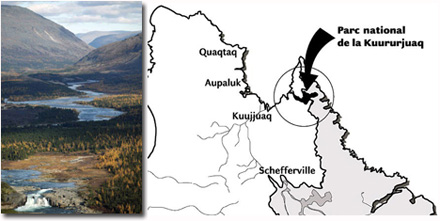
New park proposal highlights cultural and environmental heritage of the Torngat Mountains in Nunavik, and the historic traveling route of the Inuit on the Koroc (or Kuururjuaq) River flowing into Ungava Bay and the Labrador sea. Area contains some of the highest continental peaks in eastern Canada, and is known for its spectacular scenic beauty, rugged landscape, and arctic oasis of white birch (the most northern stand in Canada and a unique refuge for wildlife at this high northern latitude). The park plan is an outgrowth of a working group formed in 2002, and represents a collaboration between representatives of the Kativik Regional Government (KRG), the Village of Kangiqsualujjuaq, the village’s Landholding Corporations, the Makivik Corporation, and the Government of Quebec (Ministere du Developpement durable, de l’Environnement et des Parcs). The park provides for protection of the traditional harvesting rights of the Inuit under the James Bay and northern Quebec Agreement, and it places limits on mining development and future mining proposals in the park. Uranium and diamond mine exploration is on-going in the area. Next steps include public hearings for the park’s provisional plan and zoning proposals – scheduled for March 14 and 15, 2007, in the community of Kangiqsualujjuaq. The park plan is available on-line, and further information about the public hearings can be found here. March 5, 2007, is the deadline for written submissions.
Sources:
Filed under: First Nations, Lands and Resources, Life and Culture, Parks
Comments Off on Park national de la Kuururjuaq – Park Proposal for Torngat Mountains and Koroc River (Nunavik)
by admin ~ February 26th, 2007
1,200 mile Arctic sled-dog expedition begins this month in Iqaluit, Nunavut. NPR interview with team leader, Will Steger, can be heard here:
Weekend Edition Saturday, February 24, 2007 – Beginning this month, a team of seven explorers – including three Inuit hunters – are embarking on a 1,200-mile journey across Baffin Island in the Canadian Arctic. Traveling by dog sled, the expedition will spend time in local villages discussing the effects of Global Warming on Inuit cultures. A project of the Will Steger Foundation, the team will communicate with and educate online participants around the world.
The project is sponsored by the Will Steger Foundation, dedicated to the exploraiton and preservation of the Arctic.
Filed under: Climate Change, Expeditions, First Nations, Life and Culture
4 Comments »
by admin ~ February 26th, 2007

My good friend Tad has posted several updates on mining developments near the communities of Iskut and Telegraph Creek on his blog (Fieldnotes: Notes on the Anthropology of British Columbia).
The Galore Creek Mine: received its project approval from BC for it’s environmental assessment of the massive open pit project and access road on the watershed of the lower Stikine River. The mine has the support of the Talhtan elected leadership, and it is expected to generate up to 1000 jobs during the construction phase. The Iskut elders group, Klabona Keepers, have issued a statement opposing mining developments in the sacred headwaters region of the Nass, Stikine and Skeena Rivers.
Kemess Mine: an open pit copper-gold mine and milling complex located in the southern Toodoggone area of northern British Columbia, faces continuing opposition from the Tse Keh Nay First Nations, and concerns over cultural heritage, aboriginal rights, and environmental assessment process. Quote from news report:
Chief John Allen French of the Takla First Nation, on behalf of the Tse Keh Nay, said in a open letter this week to Premier Gordon Campbell that the tribal group’s members remain concerned about the government’s apparent support for the Kemess North mine proposal.
The project necessitates disposal of mine tailings into a local fish-bearing lake that the Tse Keh Nay describe as “a well-spring for our culture.”
“We have un-extinguished Aboriginal rights and title there, including important spiritual, hunting, fishing, medicine-gathering, burial sites and cultural sites,” French wrote.
He said the public review process for the mine “does not work for us” and needs to be fixed.
He called on the government to reconcile the tribe’s aboriginal interest with its own development aims and to revisit the Kemess North environmental assessment process with the first nation.
Update:
- Nov. 30, 2007: Fieldnotes BC continues to cover Galore Creek Mine proposal with updates on review board recommendations on Kemess North Mine proposal, and the decision by Teck Cominco and NovaGold Resources Inc. to suspend construction on the Galore Creek copper-gold project.
Filed under: First Nations, Lands and Resources, Mining
Comments Off on Galore Creek Mine on lower Stikine Watershed (B.C.)
by admin ~ February 24th, 2007
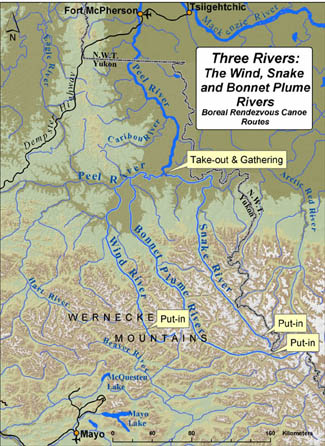 The Canadian Parks and Wilderness Society (CPAWS) lends support to Watershed Meeting in Mayo with Yukon First Nations and community elders for land use planning and protection of Peel River watershed. Its Three Rivers Campaign is set to launch a Canadian tour this April, and hopes to bring further attention to this magnificent watershed and canoeing routes. The CPAWS website is an excellent resource, and provides extensive news and trip reports for the Wind, Snake, and Bonnet Plume Rivers.
The Canadian Parks and Wilderness Society (CPAWS) lends support to Watershed Meeting in Mayo with Yukon First Nations and community elders for land use planning and protection of Peel River watershed. Its Three Rivers Campaign is set to launch a Canadian tour this April, and hopes to bring further attention to this magnificent watershed and canoeing routes. The CPAWS website is an excellent resource, and provides extensive news and trip reports for the Wind, Snake, and Bonnet Plume Rivers.
Here is the press release in full:
CPAWS-Yukon Congratulates Northern Community Elders and Delegates on their Vision of Protection for the Yukon’s Peel River Watershed, Home to the Three Rivers
22.02.07
CPAWS-Yukon is gratified by the enthusiasm and commitment to conservation expressed by community elders and delegates at the Peel Watershed Community Gathering held in Mayo, Yukon February 16-18, 2007. We fully support the communities’ vision and statement that calls for protection of the Peel Watershed for present and future generations. We look forward to continuing to work with the communities to realize their vision, which is consistent with our ongoing Three Rivers campaign.
During CPAWS-Yukon’s Three Rivers community tour from Mayo, YT to Inuvik, NWT in June 2006 (link to site), the Tetlit Gwich’in Renewable Resources Council asked us to help organize a Gathering to bring together people of Mayo, Ft. McPherson, Aklavik, Tsiigehtchic, Dawson City and Old Crow to discuss a common vision for the Peel watershed. We accepted the challenge and assisted with logistics and by sharing resource materials. Generous funding from The Walter and Duncan Gordon Foundation helped make this Gathering a reality.
Gathering outcomes will make a significant contribution to the Peel Watershed land use planning process. The Commission, tasked with planning the future of the 67,000-km2 watershed, has already heard from Ft. McPherson community members arriving home from the Gathering. The Commission will now continue to hear more unfiltered input from community people, who have proclaimed their hopes and desires for the future of this pristine area at the intersection of the boreal region and northern Yellowstone to Yukon (Y2Y).
The community vision resonates with CPAWS’ ongoing Three Rivers campaign that launches its Canadian tour this coming April. We will continue our efforts by supporting and celebrating this community milestone and move closer to protection in the magnificent Peel Watershed.
Filed under: Canoeing, First Nations, Lands and Resources, Parks, Yukon Three Rivers
Comments Off on CPAWS: Support for Peel River Watershed Meeting
by admin ~ February 16th, 2007
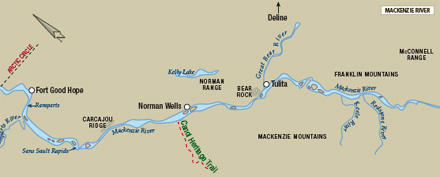
A new territorial park for CANOL Heritage Trail and Dodo Canyon promises protection for cultural heritage and new tourism opportunities for Sahtu Region of the Northwest Territories. First proposed as part of the Sahtu Dene and Metis Comprehensive Land Claim Agreement in 1994, NWT Minister Brendan Bell recently tabled a Management Plan for the Doi T’oh Territorial Park and CANOL Heritage Trail. The management plan was created in partnership with Sahtu Aboriginal land corporations. The CANOL Heritage Trail follows an access road that was used for the transport of heavy machinery during the construction of the Alaska Highway. It was also used extensively by the US Army during WWII as a land-based access route to Alaska, and for a hastily built oil pipeline to Norman Wells. It is now one of the most challenging hikes in Canada, and passes through a remote and scenic region in the heart of the Mackenzie Mountains and Carcajou River basin. Territorial park designation does not exclude the area from future subsurface mineral exploration or mineral claims. According to the press release: “The next steps in the creation of the proposed Doi T’oh Territorial Park and CANOL Heritage Trail will include: the formal transfer of Crown parklands from Canada to the Government of the Northwest Territories (GNWT); the designation of the park in Territorial Park legislation; and the establishment of a new claimant corporation to develop, operate and manage the new park.” Access to the park will likely begin at Norman Wells, where there is currently a museum dedicated to the CANOL pipeline and road.
Sources:
Filed under: First Nations, Lands and Resources, Parks
Comments Off on Minister Announces Management Plan for Sahtu Region Territorial Park
by admin ~ February 15th, 2007
 The Fort William Mountain Festival 2007 begins this week in the UK, and lasts until March 3rd. Highlights include the Best of Banff Mountain Film Festival, exhibition from the Royal Geographical Society (“Antarctic Witness: Shackleton’s Legendary Antarctic Expedition“), mountain skills and John Muir Trust writing workshops, and expedition paddling events with sea kayaker Allan Ellard and Justine Curgenven. For more information on the festival, films, and speaker line-up, you can download the program schedule from the festival site.
The Fort William Mountain Festival 2007 begins this week in the UK, and lasts until March 3rd. Highlights include the Best of Banff Mountain Film Festival, exhibition from the Royal Geographical Society (“Antarctic Witness: Shackleton’s Legendary Antarctic Expedition“), mountain skills and John Muir Trust writing workshops, and expedition paddling events with sea kayaker Allan Ellard and Justine Curgenven. For more information on the festival, films, and speaker line-up, you can download the program schedule from the festival site.
Filed under: Canoeing, Events, Film and Video
Comments Off on Fort William Mountain Festival 2007 (UK)
by admin ~ February 15th, 2007
Located 70 km north of Baker Lake, Nunavut, on the upper reaches of the Quioch River system, Cumberland Resources Ltd. received is project certificate for the Meadowbank Gold Mine in early January. Construction is set to begin on a permanent four season road this winter, and the company announced yesterday its merger with Canadian mining giant Agnico-Eagle Mines, valued at $710 million (cdn). Agnico-Eagle is a much larger company with operations in northwestern Quebec, Finland, U.S., and Mexico. With a previous timeline of 7-8 years, Aginco-Eagle mentioned in its press release it seeks a long term mining “camp” for the Meadowbank mine, no new financing, and a “long-term, respectful, and mutually beneficial relationship with the people and government of Nunavut.”
Filed under: Lands and Resources, Mining
Comments Off on Valentine’s Day Merger for Owner of Meadowbank Gold Mine
by admin ~ February 13th, 2007
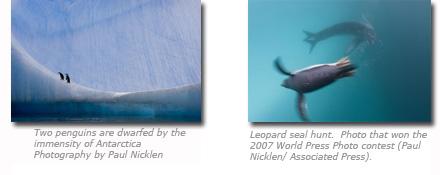
His second time winning top honors in the World Press Photo contest, Nicklen says his keen interest in watching wildlife and growing up in a small Inuit community in Baffin Island nurtured his interest in photography and photo journalism. Previously a wildlife biologist in the Northwest Territories, Nicklen says he pursued and pestered international magazines and photojournalism outlets for years before he found an audience for his photos and was invited to contribute to the National Geographic, and go out on assignment for them.(1) He first decided to turn his career to photojournalism, and to attempt to bridge the divide between scientific research and the public, after a three month solo expedition to the High Arctic. Nicken received the World Press honor this year in the nature category for his photo “Leopard Seal Hunt, Antarctica.” He currently lives outside of Whitehorse, Yukon Territories, and has a book with author Hugh Brody titled: “Seasons of the Arctic.”
Sources:
Filed under: Books, Graphic Arts, Photography
1 Comment »
by admin ~ February 10th, 2007
The CBC airs an interview with Inuit leader and activist Sheila Watt-Cloutier, who was recently nominated for a Nobel Peace Prize with Al Gore, and has worked on several international forums to raise awareness for global climate change, and its impact on Inuit subsistence, health, culture, and human rights. Challenging the assumption that the Inuit live in a remote and globally distant region, she highlights the interconnectedness of world events and industrial energy production, and speaks about the human cost of climate change and the failure to implement international treaties on greenhouse gas emissions. Also included in the broadcast is an interview with Theo Ikummaq (an Inuit hunter and expedition member of Baffin Island 2007, and contributor to the BBC news story “Hunting in the Arctic Wilderness” about climate change and Inuit subsistence).
[audio:http://podcast.cbc.ca/mp3/north_20070210_1707.mp3]
You can subscribe to the weekly CBC podcast “The North This Week” by clicking here.
Filed under: Climate Change, First Nations, Life and Culture
Comments Off on The “North This Week”: CBC Podcast Includes Interview with Sheila Watt-Cloutier
by admin ~ February 9th, 2007
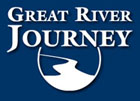 New tourism venture for the Yukon River is being proposed to attracted high-end destination tourists to riverboat excursions on the Yukon. Trips will last 8 days, and include overnight accommodations in wilderness outpost camps and lodges. INAC and the Yukon Government have provided funding for project development, market research, and training of staff. Project is said to be the first of its kind in the North, and represents an attempt to bring together adventure travel and an affluent clientele to a remote wilderness experience and the comfort of powered transportation. Project aims to have a small footprint, and take advantage of the sustainable development potential of regional geotourism. According to the tour company’s website, “The Great River Journey is a unique opportunity to develop a financially and environmentally sound, sustainable long-term business that features Yukon’s finest attributes. Joint investment by experienced private sector operators and First Nations will produce a stronger business, a superior tourism product, enhanced financial returns and long term strategic and economic benefits to both parties.” First Nations involved in the project include the Ta’an Kwach’an Council, Kwanlin Dun First Nation, Tr’ondek Hwech’in and Selkirk First Nation. Full tours are set to begin in June of 2008.
New tourism venture for the Yukon River is being proposed to attracted high-end destination tourists to riverboat excursions on the Yukon. Trips will last 8 days, and include overnight accommodations in wilderness outpost camps and lodges. INAC and the Yukon Government have provided funding for project development, market research, and training of staff. Project is said to be the first of its kind in the North, and represents an attempt to bring together adventure travel and an affluent clientele to a remote wilderness experience and the comfort of powered transportation. Project aims to have a small footprint, and take advantage of the sustainable development potential of regional geotourism. According to the tour company’s website, “The Great River Journey is a unique opportunity to develop a financially and environmentally sound, sustainable long-term business that features Yukon’s finest attributes. Joint investment by experienced private sector operators and First Nations will produce a stronger business, a superior tourism product, enhanced financial returns and long term strategic and economic benefits to both parties.” First Nations involved in the project include the Ta’an Kwach’an Council, Kwanlin Dun First Nation, Tr’ondek Hwech’in and Selkirk First Nation. Full tours are set to begin in June of 2008.
Sources:
Filed under: First Nations, History, Life and Culture, Yukon River
2 Comments »


 The Canadian Parks and Wilderness Society (CPAWS) lends support to Watershed Meeting in Mayo with Yukon First Nations and community elders for land use planning and protection of Peel River watershed. Its Three Rivers Campaign is set to launch a Canadian tour this April, and hopes to bring further attention to this magnificent watershed and canoeing routes. The
The Canadian Parks and Wilderness Society (CPAWS) lends support to Watershed Meeting in Mayo with Yukon First Nations and community elders for land use planning and protection of Peel River watershed. Its Three Rivers Campaign is set to launch a Canadian tour this April, and hopes to bring further attention to this magnificent watershed and canoeing routes. The 
 The Fort William Mountain Festival 2007 begins this week in the UK, and lasts until March 3rd. Highlights include the Best of
The Fort William Mountain Festival 2007 begins this week in the UK, and lasts until March 3rd. Highlights include the Best of 
 New tourism venture for the Yukon River is being proposed to attracted high-end destination tourists to riverboat excursions on the Yukon. Trips will last 8 days, and include overnight accommodations in wilderness outpost camps and lodges. INAC and the Yukon Government have provided funding for project development, market research, and training of staff. Project is said to be the first of its kind in the North, and represents an attempt to bring together adventure travel and an affluent clientele to a remote wilderness experience and the comfort of powered transportation. Project aims to have a small footprint, and take advantage of the sustainable development potential of regional geotourism. According to the tour company’s
New tourism venture for the Yukon River is being proposed to attracted high-end destination tourists to riverboat excursions on the Yukon. Trips will last 8 days, and include overnight accommodations in wilderness outpost camps and lodges. INAC and the Yukon Government have provided funding for project development, market research, and training of staff. Project is said to be the first of its kind in the North, and represents an attempt to bring together adventure travel and an affluent clientele to a remote wilderness experience and the comfort of powered transportation. Project aims to have a small footprint, and take advantage of the sustainable development potential of regional geotourism. According to the tour company’s .jpg)